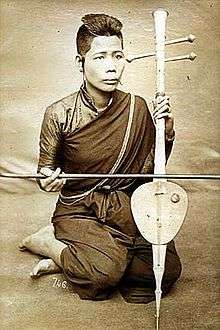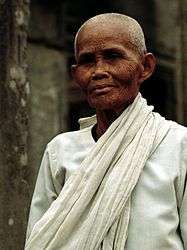Women in Cambodia
|
A Cambodian fisherwoman | |
| Gender Inequality Index | |
|---|---|
| Value | 0.473 (2012) |
| Rank | 96th |
| Maternal mortality (per 100,000) | 250 (2010) |
| Women in parliament | 18.1% (2012) |
| Females over 25 with secondary education | 11.6% (2010) |
| Women in labour force | 79.2% (2011) |
| Global Gender Gap Index[1] | |
| Value | 0.6509 (2013) |
| Rank | 104th out of 144 |
Khmer women are supposed to be modest, soft-spoken, "light" walkers, well-mannered,[2] industrious,[3] belong to the household, act as the family's caregivers and caretakers[2] and financial comptrollers,[3] perform as the "preserver of the home", maintain their virginity until marriage, become faithful wives,[2] and act as advisors and servants to their husbands.[3] The "light" walking and refinement of Cambodian women is further described as being "quiet in […] movements that one cannot hear the sound of their silk skirt rustling".[3] As financial controllers, the women of Cambodia can be identified as having real household authority at the familial level.[4]
In recent years, women have become more active in the traditionally male-dominated spheres of work and politics in Cambodia.
Work

In the wake of the Cambodian Civil War, Cambodia suffered a deficit in the number of male laborers. Thus, women took over responsibilities that were commonly and principally done by Cambodian men.[3] Under Cambodian law, women are to receive "equal pay for equal work". In practice most women receive lower wages than their male counterparts.[3] During the 1990s, many "uneducated young women" from rural areas ventured into the city to work in garment factories.[3]
In 2004, the organisation Gender and Development for Cambodia stated that 6% of the female workforce in Cambodia is paid.[5]
Religion

Cambodian women are generally active in worshipping at Buddhist temples and participating in religious ceremonies, particularly during the thngai sil (English: "holy days"). Some women not only participate as worshippers, but become Buddhist nuns (yeay chi) themselves, especially the widowed and the elderly.
Education
45% of Cambodian women were reported as being illiterate in 2004. 16% of Cambodian girls were enrolled in lower secondary schools in 2004.[5] Many Cambodian girls have been kept from education due to several factors. One factor is that they are needed at home to take care of younger siblings, perform household duties, and support the head of the home. Other factors include extreme poverty, the prohibitive distance of schools from many rural houses, and sometimes even fears for their safety when traveling alone from home to school.[3]
Although women are increasingly present in Cambodia's universities. As of 2004, 20% of graduates from universities were female.[5]
Political status
In general, from the 1980s up to the present, the number of female participants in Cambodian politics has remained low, and they are under-represented in high-level positions at both the local and national levels of the government.[3] Since 1993 there has been a modest rise in Cambodian women’s participation, including leadership, in non-governmental organizations focusing on the issues and rights of women.[3]
It was reported in 2004 that 10% of National Assembly members, 8% of Commune Council members and 7% of judges were women.[5]
Legal status
In Cambodian legislation and indeed the country's history, men and women have always technically had equal rights before the law.[3] This proclamation is also stated in the Constitution of Cambodia.[3] Women benefit from inheritance laws, wherein they can own property, they can "bring property into a marriage", they can retrieve the said property if they decide to do so, and they can easily obtain a divorce.[3]
Prostitution
Prostitution in Cambodia involves the hiring or forcible prostitution of both local women[3] and women from Vietnam,[6] and is being linked to the sex trade in nearby Thailand. In part because of the spread of prostitution, around 2.8% of Cambodia’s population are infected with HIV/AIDS.[3]
Welfare
In rural communities, Cambodian women are generally susceptible to domestic violence, and in practice have "little legal recourse". [4] Due to limited women's education, some Cambodian women are unable to protect themselves from discrimination, gender inequality, violence, and abuse, because they are not aware of their legal rights, and are also ignorant of global human rights standards.[5]
Gender and Development for Cambodia reported in 2004 that "23% of women have suffered physical domestic abuse".[5]
Social status
Contrary to traditional Cambodian culture, young Cambodian women have been influenced by Western ways in recent years. One trend is that some young female Cambodians, particularly in the capital of Phnom Penh, overtly consume liquors and other alcoholic beverages in restaurants. Other perceived Western influences include the sense of having equal rights between men and women, a sense of peer pressure, companionship, experimentation, family troubles, abandonment by a boyfriend, and increasingly, advertising.[7]
See also
References
- ↑ "The Global Gender Gap Report 2013" (PDF). World Economic Forum. pp. 12–13.
- 1 2 3 Chey, Elizabeth. The Status of Khmer Women, Mekong.net
- 1 2 3 4 5 6 7 8 9 10 11 12 13 14 15 The Status of Women in Society, seasite.niu.edu
- 1 2 Gender Roles and Statuses, everyculture.com
- 1 2 3 4 5 6 The Status of Women in Cambodia, Gender and Development for Cambodia, online.com.kh
- ↑ Cambodia, Factbook on Global Sexual Exploitation, uri.edu
- ↑ Women in Cambodia are increasingly becoming social drinkers. Phnom Penh Post. April 6, 2011.
Further reading
- McCarthy, Casey. Cambodia's First Lady becomes National Champion for Women's and Children's Health, February 21, 2011, un.org.kh
- Cambodia's First Lady appointed national champion for women’s and children’s health, Feature Story, February 23, 2011, unaids.org
- The Situation of Women in Cambodia, July 2004, 55 pages.
- Staff. Accelerating the Global Health Initiative: Cambodia's HIV/AIDS Efforts Put Women in the Driver's Seat, Women in Development, February/March 2011, USAID from the American people, usaid.gov
- Outreach Worker Manual, Cambodian Women's Health Project, January 1998, 60 pages, cancercontrol.cancer.gov
External links
| Wikimedia Commons has media related to Women of Cambodia. |
- Cambodian Women's Crisis Center (CWCC)
- Women's Media Centre of Cambodia
- Cambodia Women Health Organization

